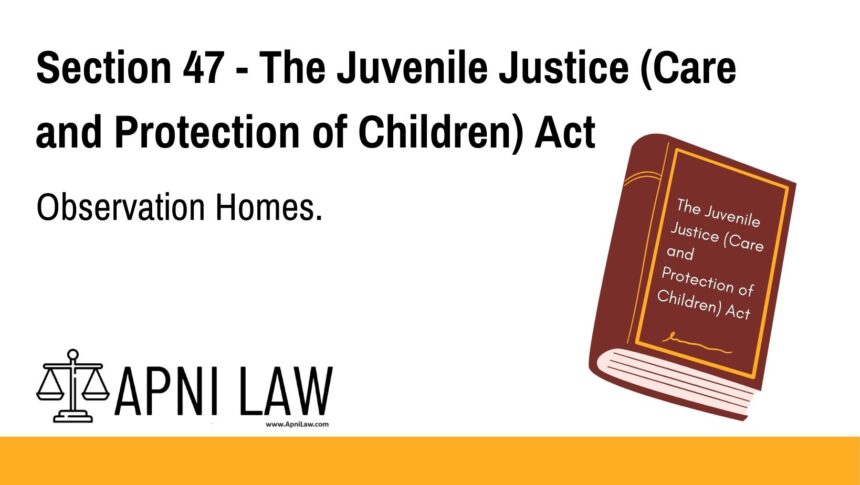Code: Section 47 — Observation Homes
(1) The State Government shall establish and maintain in every district or a group of districts, either by itself or through voluntary or non-governmental organisations, observation homes, which shall be registered under section 41 of this Act, for temporary reception, care and rehabilitation of any child alleged to be in conflict with law, during the pendency of any inquiry under this Act.
(2) Where the State Government is of the opinion that any registered institution other than a home established or maintained under sub-section (1), is fit for the temporary reception of such child alleged to be in conflict with law during the pendency of any inquiry under this Act, it may register such institution as an observation home for the purposes of this Act.
(3) The State Government may, by rules made under this Act, provide for the management and monitoring of observation homes, including the standards and various types of services to be provided by them for rehabilitation and social integration of a child alleged to be in conflict with law and the circumstances under which, and the manner in which, the registration of an observation home may be granted or withdrawn.
(4) Every child alleged to be in conflict with law who is not placed under the charge of parent or guardian and is sent to an observation home shall be segregated according to the child’s age and gender, after giving due consideration to physical and mental status of the child and degree of the offence committed.
Explanation of Section 47
Section 47 mandates that the State Government must set up Observation Homes in every district or group of districts. These homes serve as temporary shelters for children alleged to have broken the law. They provide care, rehabilitation, and a safe environment during legal inquiries.
The law allows both government-run and non-governmental organisations to operate these homes. If an institution meets the required standards, the State can register it as an observation home. The State Government must also define the rules for managing and monitoring these facilities. These rules include service standards and the process for granting or cancelling registration.
Furthermore, the section requires that children be housed based on their age, gender, and mental or physical condition. This ensures safety and appropriate care.
Illustration
Example: Short-Term Shelter for Juvenile Offenders
Ali, a 14-year-old boy, is accused of theft. The police do not send him to a jail. Instead, they place him in an observation home in his district. While his case is under inquiry, the home provides him with counseling, education, and basic needs. He is placed in a separate wing for younger boys to ensure safety and appropriate care.
Common Questions and Answers on Section 47
1. What is an observation home?
An observation home is a government-registered facility that temporarily houses children accused of committing offences. It ensures care and protection during the legal process.
2. Who runs these homes?
The State Government can operate them directly or through registered voluntary or non-governmental organisations.
3. Can any shelter become an observation home?
Yes, if the institution meets required standards and receives approval from the State Government, it can operate as an observation home.
4. How are children grouped inside these homes?
Children are separated based on age, gender, and the seriousness of their offence. Their physical and mental condition is also considered.
5. Why are these homes important?
They prevent children from being sent to adult jails and instead offer a safe space for rehabilitation during their trial.
Conclusion
Section 47 reflects the child-friendly approach of the Juvenile Justice Act. By setting up observation homes, the law aims to protect children during legal proceedings. These homes offer temporary care, rehabilitation, and safety. They also help children reintegrate into society through structured services. Overall, the section promotes a justice system focused on reform, not punishment.
For more detailed articles on child protection laws, visit ApniLaw.








